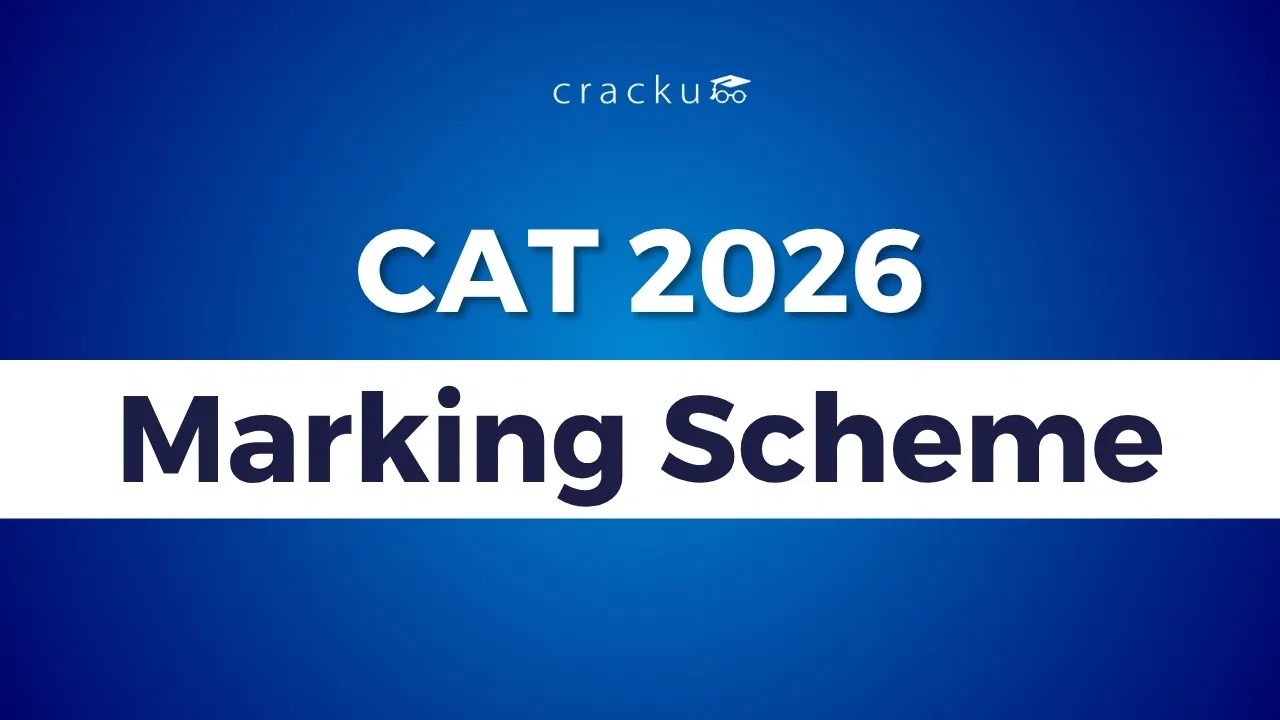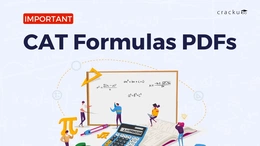CAT Marking Scheme 2026: Appearing for CAT? Understanding how marks are given and the paper marking scheme is key to scoring well. Many aspirants focus on speed but forget how important the marking scheme is. CAT is not just about solving questions, it’s about solving the right ones. This blog walks through how marking works in CAT 2026, how to avoid negative marks, how many TITA and MCQs appear, and what trends past papers show. By knowing this clearly, preparation becomes smarter. Let’s decode every section and make the strategy sharper.
CAT Marking Scheme 2026
CAT 2026 follows a simple but high-stakes marking structure. Accuracy earns marks, but guesses can cost dearly. Every section contains two types of questions, MCQs (Multiple Choice Questions) and TITA (Type In The Answer).
| Question Type | Correct Answer | Wrong Answer | Unattempted | Marking Risk |
| MCQ | +3 | -1 | 0 | High |
| TITA | +3 | 0 | 0 | Low |
MCQs reward accuracy but penalize wrong attempts. TITA questions are safer, they carry no penalty even if incorrect. Understanding this helps avoid unnecessary score drops.
Also Read, CAT Exam Pattern 2025, Marking Scheme, Duration, Structure
How Does Negative Marking Work in CAT?
Negative marking works only on MCQs. If an MCQ is wrong, one mark is deducted. TITA questions have no penalty at all. This means you can attempt TITA without fear, even if unsure of the answer.
- Every incorrect MCQ = -1 mark
- Every TITA = no penalty, even if incorrect
- Skipped questions = zero effect on total score
This makes MCQ questions risky. It's smarter to skip than to guess blindly. CAT rewards logic and accuracy, not guesswork.
Also Read, CAT Important Topics 2026, Section-wise Expected Topics
TITA vs MCQ Questions in CAT
CAT includes both TITA and MCQ questions across all sections. TITA requires typing the answer directly. MCQs give four options.
| Feature | TITA Questions | MCQ Questions |
| Options Provided | No | Yes |
| Penalty for Wrong | No | Yes (-1 mark) |
| Time to Solve | Slightly More | Slightly Less |
| Answer Format | Typed by candidate | Chosen from given options |
TITA questions test real understanding. MCQs test speed and accuracy. Smart candidates use a mix of both to maximize score.
Also Read, CAT Exam Syllabus 2026, Section-wise Pattern, Download PDF
CAT Section-wise Weightage (Detailed Breakdown)
The CAT paper has three sections. Each section is 40 minutes long. Within these sections, questions are divided between MCQ and TITA formats.
VARC – Verbal Ability and Reading Comprehension
This section checks grammar, comprehension, and vocabulary. Most questions are MCQs, but a few TITA questions appear in verbal ability.
- Total Questions: 24
- RC Questions: 16 (all MCQ)
- Verbal Ability (Parajumbles, Odd One Out, Summary): 8 (3-4 are TITA)
- Focus Area: Reading speed, accuracy in logic and grammar
DILR – Data Interpretation and Logical Reasoning
DILR is logic-heavy and data-centric. It often has four sets with five questions each.
- Total Questions: 22
- Data Interpretation: 2-3 sets (mix of TITA and MCQ)
- Logical Reasoning: 2-3 sets (mix of TITA and MCQ)
- TITA Count: 5 sets
- Focus Area: Tables, graphs, puzzles, sequencing, data logic
QA – Quantitative Aptitude
This section is mostly numerical and includes both MCQs and TITA. Arithmetic, algebra, geometry, and number theory are major parts.
- Total Questions: 22
- MCQs: Around 14
- TITA: Around 8
- Focus Area: Arithmetic (biggest weight), followed by algebra and modern math
| Section | Total Qs | MCQs | TITA | Time Limit |
| VARC | 24 | 20–21 | 3–4 | 40 mins |
| DILR | 22 | 12–14 | 6–8 | 40 mins |
| QA | 22 | 14 | 8 | 40 mins |
Each section contributes equally to total score. Candidates must clear sectional cutoffs to qualify for IIM shortlisting.
Also Read, CAT Notification 2025, Expected Release Date, Download PDF Link
CAT Previous Year Paper Trends (2020–2024)
Here is a detailed comparison of the last five CAT Previous papers to help understand trends in format, TITA/MCQ mix, and difficulty.
| Year | Total Qs | VARC (MCQ/TITA) | DILR (MCQ/TITA) | QA (MCQ/TITA) | Difficulty Level |
| 2024 | 68 | 21 / 3 | 16 / 6 | 14 / 8 | Moderate |
| 2023 | 66 | 20 / 4 | 12 / 8 | 15 / 7 | Moderate-High |
| 2022 | 66 | 21 / 3 | 15 / 5 | 14 / 8 | Moderate |
| 2021 | 66 | 22 / 2 | 16 / 4 | 15 / 7 | Moderate |
| 2020 | 76 | 25 / 3 | 20 / 4 | 17 / 7 | Moderate-High |
Over the years, the number of TITA questions has increased slightly. But the overall difficulty remains balanced. VARC usually has fewer TITA, while QA and DILR sections carry more.
Also Read, CAT Registration 2025, Dates, Documents Required, Form Fee
How CAT Scores Are Calculated: Step-by-Step?
The CAT exam is conducted in multiple slots, and to make the scores fair for everyone, your raw score is first scaled (normalized) and then converted to a percentile. Here’s how the process works in two main steps:
Step 1: Scaling Your Raw Score (Score Normalization)
Since different CAT slots may vary slightly in difficulty, your raw scores are adjusted to ensure everyone is judged fairly, no matter which slot they appeared in.
Here’s how it’s done:
1. Find the Average and Standard Deviation for Each Slot
For each section (VARC, DILR, QA), CAT calculates:
- The average score (mean) of all candidates in your slot.
- The standard deviation, which tells how spread out the scores are.
2. Top Performer Adjustment
CAT also looks at how the top 0.1% of students performed in each slot. This helps ensure high scorers are treated fairly even if their slot was tougher than others.
3. Apply a Statistical Formula
Now, using all that data, CAT adjusts your raw score using this formula:
Normalized Score = Overall Mean + ((Your Score − Slot Mean) ÷ Slot SD) × Overall SD
In short: your score is adjusted based on how well you performed compared to others in your slot, and then scaled to fit the overall performance pattern across all slots.
Step 2: Converting Scaled Score to Percentile
Once all the scores are normalized, CAT assigns percentile ranks to show how you performed compared to others.
1. Rank All Candidates
Candidates are ranked based on their scaled scores in each section. If two people have the same score, they get the same rank.
2. Calculate Your Percentile
Then, your percentile is calculated using this formula:
Percentile = ((Total candidates − Your rank) ÷ Total candidates) × 100
So, if 1,00,000 people appeared for CAT, and your rank is 1,000, your percentile would be:
(1,00,000 − 1,000) / 1,00,000 × 100 = 99 percentile
Also Read, Cracku's CAT 2026 Course by 5-time 100%iler
CAT Marking Scheme 2026: Conclusion
CAT 2026 rewards those who understand how the paper works, not just what to study. TITA questions can boost scores with zero risk. MCQs require strategy, not guessing. Each section has its own balance of concepts and question types. Knowing the marking scheme and question structure can help create a better mock test plan. Focus more on TITA for risk-free scoring. Practice MCQs with precision. And always track the trend, because CAT loves surprises, but patterns do help.





















